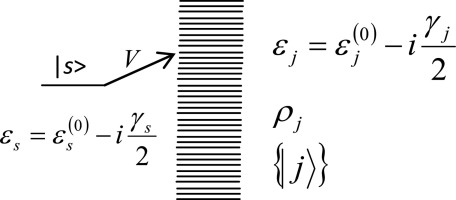Chemical Physics ( IF 2.0 ) Pub Date : 2019-12-30 , DOI: 10.1016/j.chemphys.2019.110671 Igor Khmelinskii , Vladimir I. Makarov

|
We reviewed the tools of quantum physics used in modeling of quantum coherence (QC) effects in different systems, including biological systems, which behave as quantum objects in some of their degrees of freedom. In particular, we considered the usage of the effective Hamiltonian (EH), Green’s function (GF) and density matrix (DM) methods in the analysis of QC, focusing on QC in biological systems. We discussed the two main mechanisms of loss of quantum state coherence: (i) dephasing of the originally prepared coherent wave package and (ii) population relaxation in the same wave package. Dephasing does not affect the quantum state population, e.g. as in spin-spin relaxation, where dephasing is described by the τ2 relaxation time. On the other hand, the state population relaxation of the spin wavepackage is attributed to spin-lattice relaxation and is described by the τ1 relaxation time. Presently we discussed EH and GF formalisms in terms of the complex energy, dependent on intra- and intersystem interactions that induce state population relaxation. We provided a detailed analysis of these approaches for the exciton relaxation dynamics in a glycine polypeptide chain. The same phenomena were described in the DM formalism using the relaxation matrix. We discussed QC in different biological systems, showing that QC is conserved when the interactions of the coherent wavepackage with other degrees of freedom are weak, as otherwise population relaxation causes loss of QC. We believe that our results will be useful for the researchers in the area of quantum biology.
中文翻译:

生物学中的量子相干性分析
我们回顾了在不同系统(包括生物系统)中用于建模量子相干(QC)效应的量子物理学工具,这些系统在某些自由度中充当量子对象。特别是,我们在质量控制分析中考虑了有效哈密顿量(EH),格林函数(GF)和密度矩阵(DM)方法的使用,重点是生物系统中的质量控制。我们讨论了丢失量子态相干性的两个主要机制:(i)取消最初准备的相干波包的相位和(ii)同一波包中的人口弛豫。失相不影响量子态人口,例如,如在自旋-自旋弛豫,其中去相位由τ描述2休息时间。在另一方面,自旋wavepackage的状态人口松弛归因于自旋-晶格弛豫,并且由τ描述1休息时间。目前,我们根据能量的复杂度来讨论EH和GF形式主义,这取决于诱导状态种群松弛的系统内和系统间相互作用。我们提供了这些方法的甘氨酸多肽链中的激子弛豫动力学的详细分析。DM形式主义中使用松弛矩阵描述了相同的现象。我们在不同的生物系统中讨论了质量控制,表明当相干波包与其他自由度的相互作用较弱时,质量控制是保守的,否则种群松弛会导致质量控制的损失。我们相信我们的结果将对量子生物学领域的研究人员有用。











































 京公网安备 11010802027423号
京公网安备 11010802027423号